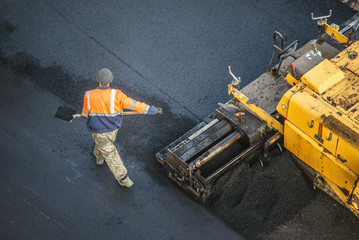Asphalt surfaces are an essential part of everyday life, providing smooth pathways for roads, driveways, parking lots, and walkways. However, exposure to heavy traffic, weather changes, and natural wear and tear can cause cracks, potholes, and other forms of damage over time. That’s where asphalt repair comes in. Proper repair and maintenance not only extend the life of asphalt surfaces but also improve safety, appearance, and functionality.

Understanding how asphalt repair works and why it is important can help homeowners, businesses, and property managers preserve their investments and avoid costly replacements in the future.
Why Asphalt Repair Matters
Asphalt repair is more than just a cosmetic fix. Cracks and potholes may look small at first, but they can quickly grow into larger problems if ignored. Water can seep beneath the surface, weakening the base and leading to more extensive damage. This can result in uneven surfaces, safety hazards, and expensive reconstruction projects.
Regular asphalt repair helps maintain structural integrity, prevents accidents, and improves curb appeal. Whether it’s a residential driveway or a commercial parking lot, timely repairs save money while ensuring that the surface remains durable and reliable for years.
Common Types of Asphalt Damage
Asphalt surfaces face a variety of challenges depending on climate, traffic, and maintenance. Some of the most common types of damage include:
- Cracks – Small fissures caused by aging, heavy loads, or temperature changes.
- Potholes – Holes that develop when water penetrates cracks and weakens the base.
- Raveling – Loose or crumbling asphalt caused by wear and exposure.
- Depressions – Low areas in the surface that collect water and create hazards.
- Fading – Loss of color and strength due to sun exposure and oxidation.
Each of these problems requires specific repair techniques to restore strength and appearance.
Methods of Asphalt Repair
There are several approaches to asphalt repair, depending on the severity of the damage:
Crack Sealing
Sealing cracks is one of the most effective preventive measures. A specialized sealant is applied to stop water from penetrating and causing further deterioration. Crack sealing is cost-effective and extends the life of the surface.
Pothole Patching
Potholes are repaired by cleaning the damaged area and filling it with hot or cold asphalt mix. This method restores the surface quickly and prevents additional damage. Patching is essential for safety, as potholes can cause vehicle damage or accidents.
Overlaying
For surfaces that show widespread wear but still have a strong base, an asphalt overlay may be the best option. A new layer of asphalt is applied over the existing surface, giving it a smooth and fresh appearance.
Milling and Resurfacing
When damage is extensive, milling and resurfacing may be necessary. The top layer of asphalt is removed, and a new one is installed. This process provides a long-lasting solution and greatly improves durability.
Sealcoating
Sealcoating is a protective layer applied to asphalt to shield it from water, oil, and UV damage. While it does not repair existing damage, it prevents future problems and keeps the surface looking new.
Benefits of Regular Asphalt Repair
Investing in asphalt repair offers numerous advantages, both immediate and long-term:
- Enhanced Safety – Smooth, even surfaces reduce the risk of accidents for drivers, cyclists, and pedestrians.
- Improved Appearance – A well-maintained asphalt surface boosts curb appeal and creates a positive impression.
- Cost Savings – Addressing small issues before they worsen prevents costly reconstruction.
- Extended Lifespan – Proper maintenance helps asphalt surfaces last longer, maximizing the value of the investment.
- Environmental Benefits – Repairing asphalt instead of replacing it reduces waste and conserves resources.
When to Schedule Asphalt Repair
Knowing when to schedule repairs is key to preventing major issues. Property owners should look out for visible cracks, potholes, pooling water, or uneven surfaces. Discoloration and fading can also signal that the surface needs maintenance.
In general, it’s best to inspect asphalt regularly and address problems as soon as they appear. Waiting too long can lead to deeper damage, requiring more extensive and costly repairs.
Professional vs DIY Asphalt Repair
Some minor repairs, such as filling small cracks, can be handled as DIY projects. However, larger issues like potholes, overlays, or resurfacing require professional expertise. Professionals have access to the right tools, materials, and techniques to ensure lasting results.
DIY fixes may provide short-term relief but often lack durability. For long-term performance and safety, professional asphalt repair is usually the best choice.
Preventing Future Damage
While asphalt repair is necessary, prevention is equally important. Here are a few tips for keeping surfaces in top condition:
- Schedule regular inspections to catch early signs of damage.
- Sealcoat every few years to protect against water and UV exposure.
- Keep surfaces clean from debris, oil, and chemicals.
- Ensure proper drainage to prevent standing water.
- Limit the weight of heavy vehicles when possible.
By combining preventive maintenance with timely repairs, property owners can ensure their asphalt surfaces remain strong and functional for decades.
The Future of Asphalt Repair
Technology continues to improve asphalt repair techniques, making them more efficient and eco-friendly. New materials and processes are being developed to increase durability, reduce environmental impact, and lower costs. As innovation advances, asphalt repair will become faster, more sustainable, and more effective.
Asphalt repair plays a crucial role in maintaining safe, durable, and attractive surfaces. From crack sealing and pothole patching to resurfacing and sealcoating, each method serves to extend the lifespan of asphalt while reducing long-term costs. Regular maintenance not only improves safety but also enhances property value and curb appeal.
By addressing damage early and investing in quality repairs, homeowners, businesses, and property managers can enjoy smooth, reliable surfaces that stand the test of time. Asphalt repair is more than a simple fix—it’s an investment in strength, safety, and sustainability.